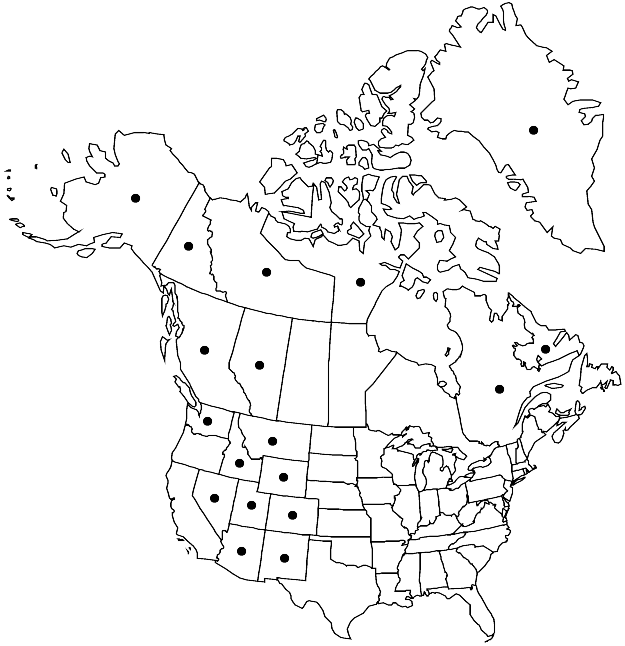Draba crassifolia
Edinburgh New Philos. J. 7: 182. 1829.
Annuals or perennials; (short-lived); caudex branched (when present); usually scapose. Stems unbranched or, rarely, branched distally, (0.1–) 0.3–1.1 (–1.5) dm, usually glabrous throughout, rarely pubescent proximally, trichomes simple, 0.3–0.7 mm. Basal leaves rosulate; petiolate; petiole ciliate throughout; blade oblanceolate to obovate, (0.2–) 0.5–2.5 (–3) cm × (1–) 2–4 (–6) mm, margins usually entire, rarely denticulate, (sometimes ciliate), surfaces glabrous or sparsely pubescent, with simple and 2-rayed trichomes, 0.3–0.9 mm. Cauline leaves usually 0, rarely 1; sessile; blade oblong to ovate, margins entire, surfaces glabrous. Racemes (2–) 4–15 (–25) -flowered, ebracteate, elongated in fruit; rachis slightly flexuous or straight, glabrous. Fruiting pedicels horizontal to divaricate-ascending, usually straight, rarely curved upward, 3–8 (–10) mm (subequaling or shorter than fruit), glabrous. Flowers (chasmogamous, petaliferous); sepals (green or purplish), ovate, 1–2 mm, glabrous; petals yellow (often fading white), oblanceolate, 1.5–2.5 (–3) × 0.5–1 mm; anthers ovate, 0.15–0.25 mm. Fruits usually narrowly elliptic to lanceolate, rarely linear-lanceolate, plane, flattened, (3–) 5–10 × 1.5–2.5 mm; valves glabrous; ovules (8–) 16–24 (–30) per ovary; style 0.02–0.1 mm. Seeds elliptic, 0.7–0.8 × 0.4–0.5 mm. 2n = 40.
Phenology: Flowering Jun–Sep.
Habitat: Rock outcrops and talus, subalpine meadows, alpine summits and tundra, bare snow-melt areas
Elevation: (50-)1000-4300 m
Distribution

Greenland, Alta., B.C., Nfld. and Labr. (Labr.), N.W.T., Nunavut, Que., Yukon, Alaska, Ariz., Colo., Idaho, Mont., Nev., N.Mex., Utah, Wash., Wyo., n Europe (Norway), n Europe (Sweden)
Discussion
M. D. Windham (2004) presented morphological and chromosomal data suggesting that Draba crassifolia is an allopolyploid produced by hybridization between D. albertina and D. fladnizensis. Although the species is distinctive in large part, some individuals can be difficult to place and there is evidence of rare backcrossing (Windham, unpubl.). The attribution to Arizona is based on Schaack 345 (US) and Kearney & Peebles 12156 (US), both collected on the San Francisco Peaks in Coconino County. Draba crassifolia is found at elevations as low as 50 m in Greenland and the islands of Nunavut.
Selected References
None.
Lower Taxa
"elongated" is not a number."thick" is not a number."dm" is not declared as a valid unit of measurement for this property."dm" is not declared as a valid unit of measurement for this property.